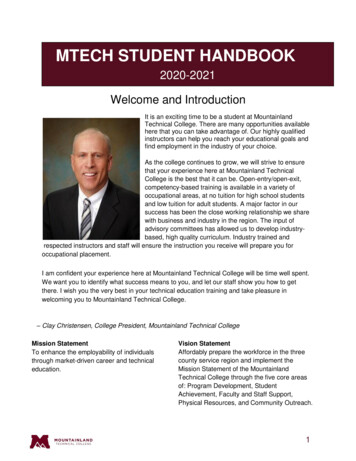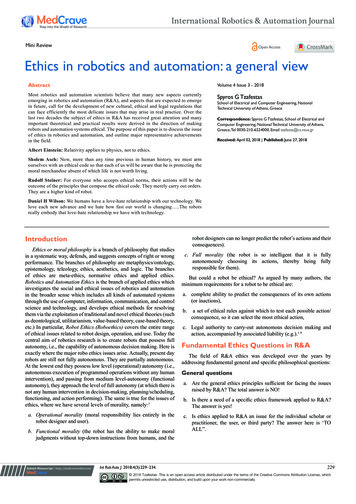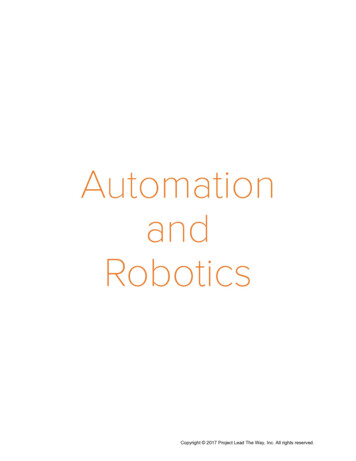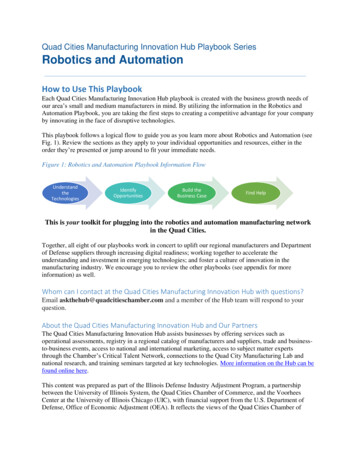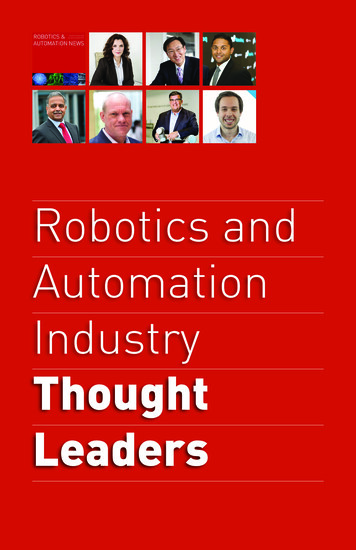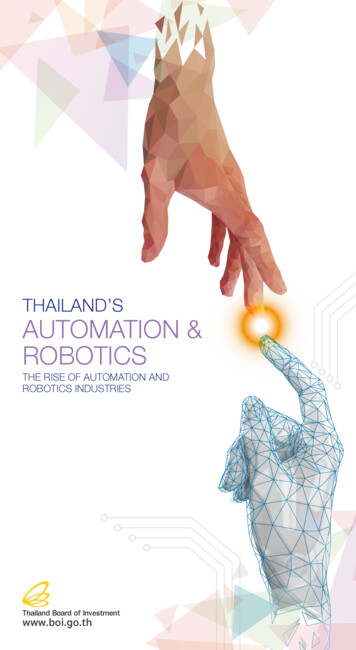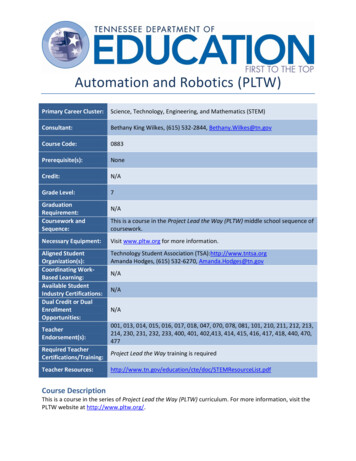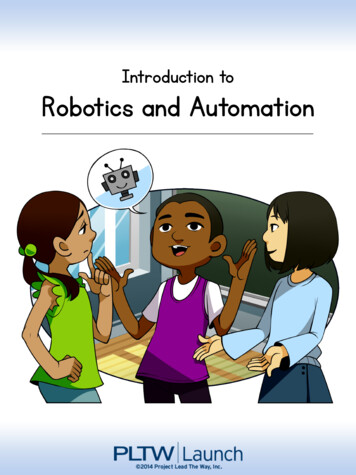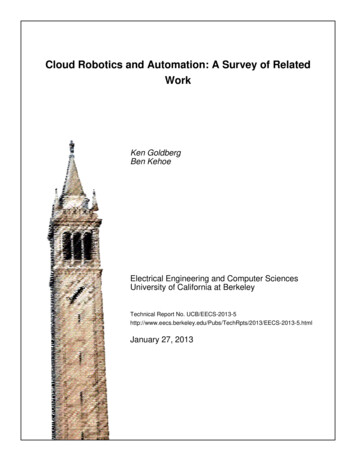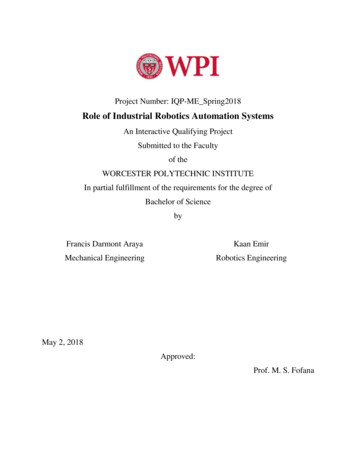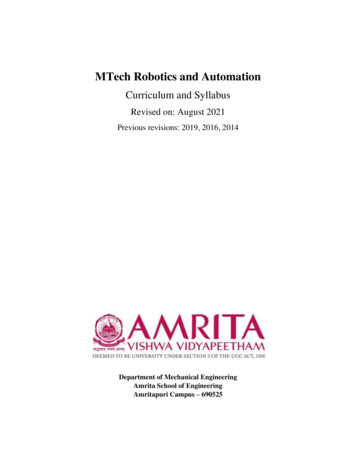
Transcription
MTech Robotics and AutomationCurriculum and SyllabusRevised on: August 2021Previous revisions: 2019, 2016, 2014Department of Mechanical EngineeringAmrita School of EngineeringAmritapuri Campus – 690525
PrefaceRobotics, the branch of technology that deals with the design, construction,operation, and application of robots, has become a highly relevant and upcomingdiscipline. It is being increasingly applied to almost every field of activity includingimproving the standard of living of humans, handling dangerous and hazardoussituations, relieving mankind of repetitive and tiring activities, exploring outer spaceand performing complex medical procedures. Many industries also use robots intheir manufacturing facilities and research. For instance, robots are used in areas likehigh heat welding and continuous handling of heavy loads. They can functiontirelessly even in the most inhospitable working conditions. Owing to this, robotsare taking over from man most of the manipulative, hazardous and tedious jobs infactories, mines, atomic plants, spaceships, deep-sea vessels, etc. The automation ofwork through robotics has led to substantial increase in productivity in these areas.Given its diverse applications, the robotics field today demands in-depth knowledgeof a broad range of disciplines such as electronics, computers, instrumentation andmechanics. A graduate entering the workforce in the area of robotics must bethoroughly familiar with intelligent systems and proficient in computer vision,control systems, and machine learning, as well as the design and programming ofrobotic systems. Specialization in automation also requires the student to apply awide range of engineering principles in order to understand, modify or control themanufacture, delivery and maintenance of technology components in a broad rangeof industries. Graduates must know how to develop and maintain systems that costeffectively optimize productivity and quality control.The Amrita Vishwa Vidyapeetham Robotics and Automation MTech Program isunique in that it provides an academic curriculum that pulls from MechanicalEngineering, Electrical and Electronics Engineering, Instrumentation Engineeringand Computer Science disciplines, exposing the students to the breadth of andinterdependence among the engineering disciplines and offering the students exactlywhat is required to master the technical knowledge required.This MTech program will provide a comprehensive educational environment andenable students to gain expertise in next generation robotics and automation systems.By exposing our students to do course work from multiple disciplines and preparingthem to think about robotics from a holistic approach, our program will prepare askilled industry workforce as well as expert researchers who will be able to provideleadership in a world that is increasingly dependent on technology.
Program Educational Objectives of the MTech (Robotics and Automation)PEO1: This program provides an academic curriculum that pulls from Mechanical Engineering,Electronics and Instrumentation engineering and Computer Science disciplines, exposing thestudents to the breadth of and interdependence among the engineering disciplines and offering thestudents exactly what is required to master the technical knowledge required.PEO2: This programme provides a comprehensive educational environment and enables studentsto gain expertise in next generation robotics and automation systems.PEO3: Expose students to course work from multiple disciplines and prepare them to think aboutrobotics from a holistic approach and prepare a skilled industry workforce as well as expertresearchers who will be able to provide leadership in a world that is increasingly dependent ontechnology.Program Outcomes (POs)PO1: An ability to independently carry out research /investigation and development work tosolve practical problems.PO2: An ability to write and present a substantial technical report/document.PO3: Students should be able to demonstrate a degree of mastery over the area as per thespecialization of the program. The mastery should be at a level higher than therequirements in the appropriate bachelor program.
CURRICULUMSemester urse TitleMathematics for Robotics and AutomationControl SystemsKinematics and Dynamics of RobotsDigital Image ProcessingMachine LearningAmrita Values Program*Career Competency I*Total Credits* Non-credit CourseL33333CreditsT P Total0 240 240 240 240 24P/FP/F20Semester 2121HU603CourseTypeSCSCSCEESCHUCourse TitleMechatronic Devices and SystemsIndustrial AutomationAutonomous Robot SystemsElective IElective IIResearch MethodologyCareer Competency II*Total Credits* Non-credit CourseL333332CreditsT P Total0 240 240 240 240 240 02P/F22Semester 3Sl.No.CourseCode121RA798CourseTypePCourse TitleDissertation - Stage ICreditsL T P Total12# FC – Foundation Core, SC – Subject Core, E – Elective, HU – Humanities, P - ProjectSemester 4Sl.No.CourseCode121RA799CourseTypePCourse TitleDissertation - Stage IITotal Credits for MTech Program: 68CreditsL T P Total14
Electives I and EEEEEE18ECourse TitleIndustrial FocusCNC MachinesProcess Control and InstrumentationAdvanced Process ControlFPGA based System DesignEmbedded System DesignEmbedded Real Time SystemsData Driven Methods for Robotic SystemsEssentials for Mechatronic PrototypingResearch FocusProbability and Statistics (Open Elective)Humanoid RoboticsSwarm IntelligenceBehavioural RoboticsFrontiers of BiomechatronicsOptimization TheoryHaptic InterfacesInnovating in TechnologyMeasuring User Interface QualityDesign for People: Principles and Practices ofHuman Centered DesignMechanisms for Robot SystemsQuadruped RobotsSoftware FocusDesign and Analysis of AlgorithmsAdvanced Perception for Robotics and AIComputational IntelligenceMachine VisionAdvanced AI for RoboticsVirtual Reality and ApplicationsNon-Linear Control TheoryExperimental HapticsUnmanned Aerial VehiclesCreditsL T P 000222222222444444444
SYLLABUS21MA617MATHEMATICS FOR ROBOTICS AND AUTOMATION3-0-2-4Unit-1 (Linear Algebra)Vector algebra, Matrices, Addition, multiplication, transpose, cofactors, determinant, trace andinverse of matrices (Revision), Linear dependence/independence of vectors, Rank of matrices,System of linear equations, Solution of system of linear equations, Vector spaces, Subspaces,Generating set, Basis, Dimension of vector spaces, Linear mapping, Transformation matrix, Basischange, Image and Kernel of linear mapping, Affine spaces, Norm of a vector space, Dot product,Quadratic form, symmetric positive definite matrices, Length, angle and orthogonality,Orthonormal basis, Inner product of functions, Orthogonal projections,Gram Schmidtorthogonalization, Eigen values and vectors, Matrix decomposition: Cholesky decomposition,Eigen decomposition, Singular value decomposition, Matrix approximation. Computerprogramming exercises in matrix and vector manipulations, Eigen value & SV Decompositions,Gauss elimination for the solution of system of equations.Unit-2 (Vector calculus)Univariate, Multivariate and vector functions, Motion of a particle in space, Differentiation andTaylor’s series expansion of univariate functions, Partial differentiation, chain rule, Gradient ofvector function(Jacobian), Gradient of a vectors with respect to a matrix, Gradient of matrices withrespect to a matrix, Identities for computing gradients, Back propagation and automaticdifferentiation, Gradients in deep neural networks, Higher order partial derivatives, Hessian,Taylor’s series expansion of multivariate functions, Quadratic forms, Unconstrained optimizationproblems, Method of steepest descends, Conjugate gradient Method. Vector calculus for physicalfield problems, Directional derivative and direction of maximum derivative, divergence and curlof vector fields, rotational and irrotational vector fields, Conservative vector fields, Vector integralcalculus, line, surface and volume integrals, Stokes theorem, Green's theorem and Gaussdivergence theorem, applications of vector calculus theorems to field problems, Algebra ofCartesian Tensors, Index notation, Isotropic tensors, Invariants of a tensor, Computerprogramming exercises based on these topics.Unit-3Random experiment, Sample space, Event space, Probability, Probability space, Discrete andcontinuous probabilities, PMF, CDF, PDF, sum and product rules, Conditional probability, Bayestheorem, Mean, Variance, Covariance , Correlation, Empirical means and covariances, Statisticalindependence, Conditional independence, Inner products, Gaussian distribution, Marginal andconditional of Gaussian, Product of Gaussian distributions, Sums and linear transformations,Conjugacy and exponential family, Binomial, Poisson and Beta distributions, Change of variables,Computer programming exercises based on these topics.Differential equations: Types, Computer numerical solution for: Euler method, Runge-KuttaMethod, Adam Bashforth method, Explicit and implicit methods, Fourier spectral method.
TEXTBOOKS/REFERENCES:[1] Marc Peter Deisenroth, A. Aldo Faisal, Cheng Soon Ong, “Mathematics for MachineLearning”, Cambridge University Press, 2020.[2] Ervin Kreyszig, “Advanced Engineering Mathematics”, 10th edition, Wiley, 2015.[3] Gilbert Strang, “Linear algebra and its applications”, 5th edition, Cengage Learning, 2018.[4] Richard A Johnson, “Miller and Freund's - Probability and Statistics for Engineers”, 7thEdition, Pearson, 2008.[5] George F Simmons, “Differential equations with applications and Historical notes”, TataMcGraw Hill, 3rd edition, Taylor & Francis, 2016.[6] Kevin Murphy, “Machine leaning: A probabilistic perspective”, MIT Press, 2012.Course OutcomesCO1: Capability to solve problems in linear algebra.CO2: Capability to do differentiation for solving optimization problems.CO3: Capability to solve problems in probability and develop probabilistic models.CO4: Capability to solve problems using computers.21RA601CONTROL SYSTEMS3-0-2-4Mathematical Modeling of physical systems- Transfer function-stability with reference to 's' plane,transient and steady state analysis, steady state errors, Performance Indices. controllers- P, PI andPID modes of feedback control.Analysis of control systems in state space -State space model of a system, state transition matrix,state space representation in canonical forms, solution of homogeneous state equations,controllability and observability.Design of control systems in state space- Design by pole placement, State Feedback gain usingAckerman's formula. State Observers- Full order observer, reduced order observer, Design ofcontrol system with observers.(Laboratory session on the topic Using MATLAB)Digital control system: Sampled data systems, sampling, quantization, data reconstruction andfiltering of sampled signals. Z transfer function, mapping from s plane to z plane.Z transform analysis of closed loop and open loop systems, Stability analysis of closed loopsystems in the z plane: stability tests. State space analysis of sampled data systems- Controllability,observability, control law design, decoupling by state variable feedback, Estimator/Observerdesign: full order observers, reduced order observers.(Laboratory session on the topic Using MATLAB)Nonlinear systems: Introduction - characteristics of nonlinear systems. Types of nonlinearities.Analysis through Linearisation about an operating point. Stability Analysis- Definition of stabilityasymptotic stability and instability - Liapunov methods to stability of linear and nonlinear systemsIntroduction to robot control, Control schemes used for a robotic manipulator-Joint motion control,Resolved motion control, and Adaptive control schemes.
(Laboratory session on the topic Using MATLAB)TEXTBOOKS/REFERENCES:[1] Norman Nise, “Control System Engineering”, John Wiley & Sons, Inc., Sixth Edition, 2011.[2] Dorf R. C. and Bishop R. H, “Modern control systems”, 12th Edition, Prentice Hall[3] Katsuhiko Ogata, “Modern Control Engineering”, fifth edition, Prentice Hall of India Pvt. Ltd.,New Delhi, 2015.[4] Benjamin C. Kuo, “Automatic Control Systems”, Prentice Hall India Ltd, Sixth Edition, 2000.[5] Loan Dore Landau, Gianluca Zito, “Digital Control Systems: Design, Identification andImplementation”, Springer, 2006.[6] K. Ogata, “Discrete-Time Control Systems”, Pearson Education, 2011.[7] M. Sami Fadali, Antonio Visioli, “Digital Control Engineering: Analysis and Design”,Elsevier, 2013.[8] M. Gopal, “Digital Control and State Variable Methods”, Tata McGraw-Hill, 2006.[9] M. Vidyasagar, "Nonlinear systems analysis", Second Edition, Prentice Hall, 1993.[10] Dawson, D. M., Abdallah, C. T., Lewis, F. L. "Robot Manipulator Control: Theory andPractice". Ukraine: CRC Press, 2003.[11] K.S. Fu, R.C. Gonzalez, C.S.G. Lee "Robotics: control, sensing, vision and intelligence", TataMcGraw-Hill, 2008.Course OutcomesCO1: Model control systems in the continuous domain using classical control approach.CO2: Analyze control systems using state space models.CO3: Design state feedback controllers and state observers for continuous time and discrete timeSystems.CO4: Understand the nonlinear systems characteristics and analyze the stability of nonlinearSystems.CO5 Understand the control schemes used for robotic manipulators.CO6: Use software tools for the analysis and design of control systems.21RA602KINEMATICS AND DYNAMICS OF ROBOTS3-0-2-4Robot types, trends, applications, classification - Anatomy and Architecture of Manipulators –Mobile Robots – Advanced Robots - Holonomic and Non-holonomic Robots - Transformations –Quaternions - Robot Kinematics: Forward and Inverse - Manipulator Jacobian - Force relations –Multi-body Dynamics: Forward and Inverse – Lagrange-Euler Dynamic Model – RecursiveNewton-Euler Formulation - Trajectory planning in Joint space and Cartesian space –Matlab/RoboAnalyzer Simulations of Kinematic and Dynamic models.TEXTBOOKS/REFERENCES:[1] S K Saha, “Introduction to Robotics”, 2nd edition, McGraw Hill Education (India) Pvt. Ltd.,2014.[2] Robert J Schilling, “Fundamentals of Robotics, Analysis and Control”, Prentice Hall, 2007.
[3] Reza N Jazar, “Theory of Applied Robotics: Kinematics, Dynamics and Control”, 2nd Ed.Springer, 2010.[4] Peter Corke, "Robotics, Vision, and Control: Fundamental Algorithms in MATLAB",Springer, 2013.[5] John J Craig, “Introduction to Robotics: Mechanics and Control”, Pearson, 2018.[6] K S Fu, et al, “Robotics: Control, Sensing, Vision and Intelligence”, Tata McGraw Hill,2008.[7] Springer Handbook of Robotics, B Siciliano, O Khatib, editors, 2nd Ed., Springer, 2016.Course OutcomesCO1: Understand various robot classifications, specifications and applications.CO2: Apply coordinate transformations to map position and orientation coordinates from endeffector to robot base.CO3: Apply forward and inverse kinematics to manipulate objects by robots.CO4: Analyze forward and inverse kinematics to manipulate objects by robots.CO5: Analyze forward and inverse dynamics to manipulate objects by robots.CO6: Construct simulations in RoboAnalyzer/Matlab to verify kinematics and dynamics ofrobots.21RA603DIGITAL IMAGE PROCESSING3-0-2-4Two-Dimensional Signals and Systems: Two-dimensional convolution, 2D Discrete-SpaceFourier Transform, Inverse 2-D Fourier Transform, Fourier Transform of 2-D or SpatialConvolution, Symmetry properties of Fourier Transform, Continuous-Space Fourier Transform.Sampling in two dimensions: Sampling theorem, Change in Sample rate, Down sampling, Idealdecimation, Up sampling, Ideal interpolation. Continuous Image characterization: Psychophysicalvision properties, Photometry, Colorimetry. Fundamentals of Digital Image Processing: Imageacquisition - Various modalities, Image sampling and quantization, mathematical representation,Image reconstruction based on interpolation. Gray level transformation, Histogram processing,Arithmetic and logic operations. Transform and filtering: Intensity transformation and spatialfiltering, filtering in frequency domain, Image restoration and reconstruction, Binary imagemorphology. Smoothing and sharpening filters, Line detection, Edge detection, Zero crossings ofthe second derivative. DFT, smoothing in frequency domain filtering, Sharpening in frequencydomain filtering. Degradation model, noise models, restoration in spatial domain, restoration infrequency domain. Estimation of degradation function, inverse filtering, Wiener filtering,constrained least square filtering. Color Image Processing: Color Models, the RGB Color Model,the CMY and CMYK Color Models, the HSI Color Model, Pseudo color image processing, Basicsof Full Color Image Processing, Smoothing and Sharpening, Image Segmentation Based on Color.Image Segmentation-Point, Line, and Edge Detection, Thresholding-Types Boundary based andRegion-Based Segmentation. Representation of Boundary Descriptors, Regional DescriptorsTexture descriptors. Matlab applications.
TEXTBOOKS/REFERENCES:[1] John W Woods, "Multidimensional Signal, Image and Video Processing and Coding",Academic Press, 2006.[2] Rafael C. Gonzalez and Richard E. Woods, “Digital Image Processing”, Third Edition,Pearson Education, 2009.[3] William K. Pratt, “Digital Image Processing”, John Wiley, New York, 2007.[4] Kenneth R. Castleman, "Digital Image Processing", Prentice Hall, 1996.[5] Gonzalez, Woods and Eddins, "Digital Image Processing using MATLAB", Prentice Hall,2004.Course OutcomesCO1: Understand 2D signals and systems.CO2: Apply sampling in two dimensions.CO3: Apply fundamentals of digital image processing.CO4: Analyze transforms and filtering.CO5: Analyze color image processing.CO6: Construct simulations in Matlab to study digital image processing.21RA604MACHINE LEARNING3-0-2-4Introduction-ML Types- Supervised, Unsupervised, Reinforced and semi-supervised learning,Examples of ML problems, Hypothesis space and inductive bias, Evaluation and cross validation,Linear regression, Decision tree, Entropy of information, Information gain, Computer tutorials.Underfitting and overfitting, Method for reducing overfitting, Regularization, KNN, Curse ofdimensionality, Feature selection, Feature extraction, PCA, Bayesian learning, Naive Bayes,Logistic regression, Support Vector Machine (SVM), Nonlinear SVM and Kernel Function,Computer tutorials. Computational Learning theory, Finite hypothesis space, VC dimension,Introduction to ensembles, Bagging and Boosting, Introduction to clustering, K-means clustering,Agglomerative Hierarchical Clustering, Computer tutorials.TEXTBOOKS/REFERENCES:[1] Trevor Hastie, Robert Tibshirani and Jerome Friedman, “The Elements of StatisticalLearning, 2nd edition, Springer, 2009.[2] Tom M. Mitchell, “Machine Learning”, McGraw Hill Education, 2017.[3] Marc Peter Deisenroth, A. Aldo Faisal, Cheng Soon Ong, “Mathematics for MachineLearning”, Cambridge University Press, 2020.[4] Stuart J. Russel and Peter Norvig, “Artificial intelligence: A modern approach”, PearsonEducation Inc, 2009.Course OutcomesCO1: Understand issues and challenges of machine learning: data, model selection, modelcomplexity.
CO2: Design and implement various machine learning algorithms in a range of real-worldapplications.CO3: Understand strengths and weaknesses of many popular machine learning approaches.CO4: Analyze the underlying mathematical relationships within and across Machine Learningalgorithms.CO5: Apply the paradigms of supervised and un-supervised learning.21RA611MECHATRONIC DEVICES AND SYSTEMS3024Sensors: General Concept of Measurement: Basic block diagram, stages of generalisedmeasurement system, state characteristics; accuracy, precision, resolution, repeatability,reproducibility, sensitivity, zero drift, linearity, Dynamic characteristics, zero order instrument,first order instrument, time delay, Sensors and Principles: Resistive sensors, Potentiometer andstrain gauges Inductive sensors: Self-inductance type, mutual inductance type, LVDT Capacitivesensors- piezoelectric sensors, thermocouples, thermistors radiation pyrometry - Fibre optictemperature sensor photo electric sensors, pressure and flow sensors, vision sensors.Signal conditioning: Amplification, Filtering, Level conversion, Linearisation, Buffering, sampleand hold circuit quantisation multiplexer/ demultiplexer, analog to digital converters, digital toanalog converters. Data acquisition and conversion: General configuration single channel andmultichannel data acquisition system. Digital Filtering, data logging, data conversion, introductionto digital transmission systems, PC-based data acquisition system. Interface systems and standards.Microcontroller fundamentals: ARM ASM programming and basics of C; IO Interfacing: LEDand Switch; Design and Development Process: Architecture, Micro architecture, Design,Implementation, Verification and Validation; Development Tools: Block Diagrams, Flow Charts,Call Graphs, Dataflow Graphs, Finite State Machines; The Parallel Interface: GPIO; The SerialInterface: UART; PLL programming; Timer: SysTick; Fixed Point; Software: Structs, Stacks andRecursion; IO Synchronization; Interrupts; DAC: Music Synthesis and Music Playback; ADC:Real world interfacing and Data Acquisition. Labs include prototypes of actual embedded systemsusing Arduino, Raspberry Pi 4 and others.TEXTBOOKS/REFERENCES:[1] Doeblin E.O., “Measurement Systems”, McGraw Hill, 1995.[2] Jonathan Valvano, “Embedded Systems: Introduction to ARM Cortex -MMicrocontrollers”, Fourth Edition, Create Space Publishing, 2013.[3] Michael Margolis, “Arduino Cookbook”, O'Reilly Media, 2014.[4] Massimo Banzi and Michael Shiloh, “Getting Started with Arduino”, Third Edition, 2014.[5] Edward A. Lee, and Sanjit A. Seshia, “Introduction to Embedded Systems- A Cyber PhysicalSystems Approach”, Second Edition, 2015.Course OutcomesCO1: Understand general concept of measurement in sensors.CO2: Apply principles of sensors.
CO3: Apply fundamentals of signal conditioning.CO4: Analyze data acquisition and conversion.CO5: Analyze microcontroller programming.CO6: Construct embedded systems using Arduino, Raspberry Pi.21RA612INDUSTRIAL AUTOMATION3-0-2-4Introduction to Industrial Automation with case studies. Introduction to Industry 4.0.Introduction to PLC based controls - Architecture of PLC, PLC networking, programming, andwiring, HMI and SCADA design for PLC, Simulations of Factory Automation.Introduction to Pneumatic and Hydraulic Systems - Systems components, Symbols, System designand simulation using Automation Studio.Introduction to Electric motors - Motor controls: VFD and Servo drives, Matlab Simulations.TEXTBOOKS/REFERENCES:[1] Anthony Esposito, "Fluid Power with Applications", 7th ed., Pearson Publishers.[2] Kothari, Dwarkadas Pralhaddas, and I. J. Nagrath, “Electric machines”, Tata McGraw-HillEducation, 2004.[3] Frank D. Petruzella, "Programming Logic Controllers", McGraw Hill Book Company[4] Product Manuals: AB PLC 1400 Series A, AB Panel View HMI, AB VFD, AB Servo Drive.[5] Vedam Subrahmaniam, “Electric Drives (Concepts and Applications)”, Tata McGraw-Hill,2001.[6] Nagrath I.J. and Kothari D.P., “Electrical Machines”, Tata McGraw-Hill, 1998.[7] Pillai S.K. “A First Course on Electric Drives”, Wiley Eastern Limited, 1998.[8] Groover M. P., "Industrial Robotics, Technology, Programming and Application",McGraw Hill Book and Co., 2012.[9] Siemens "PLC Handbook".[10] Ries and Ries, "Programming Logic Controllers", PHI.[11] Werner Deppert and Kurt Stoll, “Pneumatic Control”, VOGEL Buchverlag Wurzburg,Germany.[12] Majumdar S.R., “Pneumatic Systems Principles and Maintenance”, Tata McGraw Hill,New Delhi.[13] Peter Croser and Frank Ebel, "Pneumatics Basic Level TP 101" Festo Didactic GMBH &Co, Germany.[14] Hasebrink J.P. and Kobler R., “Fundamentals of Pneumatic Control Engineering”, FestoDidactic GMBH & Co, Germany.[15] Merkle D., Schrader B. and Thomes M., "Hydraulics Basic Level TP 501" Festo DidacticGMBH & Co, Germany.[16] Peter Rohner, “Industrial Hydraulic Control” John Wiley and Sons, Brisbane.
Course OutcomesCO1: Understand various components of Industrial automation.CO2: Understand PLC architecture.CO3: Apply PLC networking and programming.CO4: Analyze pneumatic and hydraulic circuits.CO5: Analyze motor controls-VFD and servo drives.CO6: Construct simulations in Automation Studio and real pneumatic and hydraulic circuits.21RA613AUTONOMOUS ROBOT SYSTEMS3-0-2-4Introduction, Types of Mobile Robots – Legged Robots, Gait Analysis, Wheeled Robots,Kinematic models for Mobile Robots, Maneuverability, Dynamic Path Planning, Scenario basedcontrol, path planning and sensor fusion, Workspace & Motion control, Sensors & Actuators forMobile Robots, Sizing and Torque Calculations, Design and implementation of estimationalgorithms for state estimation, Localization, Map-representation and Map building, Map-basedlocalization scheme, Planning and Navigation: Dijkstra’s algorithm, A* algorithm, Potential fieldmethod, Wandering standpoint algorithm, DistBug algorithm, etc. Application of Dijkstra’salgorithm, A* algorithm in Floor Cleaning Robot.Introduction to ROS - ROS Basic Concepts: Nodes, topics, parameters, services - Simple ROSprograms to publish and subscribe messages. Simulation of typical robot system in ROS:Manipulators, wheeled robots in scenarios such as in a maze etc., legged robots and UAVs invarious environments. Simulation of Husky Mobile Platform using ROS - Online Control of Huskyin a structured environment.TEXTBOOKS/REFERENCES:[1] R. Siegwart and Illah R. Nourbakhsh, “Introduction to Autonomous Mobile Robots”, MITPress, 2004.[2] Thomas Braunl, “Embedded Robotics”, Second Edition, Springer, 2006.[3] Siciliano and Khatib, “Handbook of Robotics”, Springer, 2008.[4] Witold Jacak, “Intelligent Robotic Systems: Design Planning and Control”, KluwerAcademic Publishers, 1999.[5] ROS Wiki.[6] Jason M. O’Kane, "A Gentle Introduction to ROS" ISBN 978-14-92143-23-9.Course OutcomesCO1: Understand various types of mobile robots and their kinematic models.CO2: Apply maneuverability, workspace and motion controls of mobile robots.CO3: Analyze various algorithms for SLAM.CO4: Understand basic concepts of ROS.CO5: Analyze simple programs and simulate robots in ROS.CO6: Construct simulations of Husky mobile platform using ROS.
21RA701CNC MACHINES3-0-2-4Introduction: NC Machines, CNC Machines, CNC Machine Components, Co-ordinate System,Working Principle of Various CNC Systems, Direct Numerical Control, Adaptive Control,Constructional Features of CNC Machines: Introduction-Machine Structure-Guideways-BallScrews-Accessories of Machining Centre-Spindle Drives and Feed Drives-Control System of NCMachine Tools, CNC Part Programming: Part Programming Fundamentals- G and M CodesInterpolation Systems-Methods of CNC Part Programming-APT Language-Motion CommandsCNC Part Programming Using CAD/CAM-Computer Automated Part Programming, Tooling andWork Holding Devices: Cutting Tool Material-Preset and Qualified Tools-ISO Specification ofTools-Chip Breakers-Principle of Location-Clamping-Work Holding Devices. Economics andMaintenance: Introduction-Factors Influencing Selection of CNC Machines-Cost of Operation ofCNC Machines-Practical Aspect of Introducing a CNC-Maintenance of CNC MachinesPreventive Maintenance Programs.TEXTBOOKS/REFERENCES:[1] M. Adithan, B.S. Pable, “CNC Machines”, New Age; Third edition, 2018.[2] P. M. Agrawal, V. J. Patel, “CNC Fundamentals and Programming”, V. J. Patel Edition: 2ndEdition: 2017.[3] Peter Smid, “CNC Programming Handbook: A Comprehensive Guide to Practical CNCProgramming”, Industrial Press Inc., U.S.; 2nd edition, 2000.[4] P. N. Rao – “CAD/CAM, Principles and Applications” - Tata McGraw Hill Publishers –2004.[5] Mikell P. Groover and Emory W. Zimmers – “CAD/CAM” - PHI Publishers - 2002.[6] Thomas Crandell, “CNC Machining and Programming: An Introduction”, Industrial Press,Inc., 2nd edition, 2003.Course OutcomesCO1: Understand various components of NC and CNC machines and their working principles.CO2: Understand constructional features of CNC machines.CO3: Apply part programming in CNC machines.CO4: Analyze simulation for CNC turning operations.CO5: Analyze simulation for CNC milling operations.CO6: Analyze economics and maintenance of CNC machines.21RA702PROCESS CONTROL AND INSTRUMENTATION3-0-2-4Process Modeling: Hierarchies. Theoretical models: transfer function, state space models, and timeseries models. Development of empirical models from process data- chemical reactor modeling.Feedback & feed forward control, cascade control, selective control loops, ratio control, feedforward and ratio control. Multi-loop and multivariable control: process interactions, singularvalue analysis. PID design, tuning, trouble shooting, tuning of multiloop PID control systems.Decoupling control: strategies for reducing control loop interactions. Instrumentation for process
monitoring: codes and standards, preparation of P&I diagrams. Model predictive control.Statistical process control, supervisory control, direct digital control, distributed control, PC basedautomation. Programmable logic controllers: organization, programming aspects, ladderprogramming, final control elements. SCADA in process automation. Case studies.TEXTBOOKS/ REFERENCES:[1] Dale E. Seborg, Duncan A. Mellichamp, Thomas F. Edgar and Francis J. Doyle “ProcessDynamics and Control”, John Wiley and Sons, 2010.[2] Ernest O. Doebelin, “Me
factories, mines, atomic plants, spaceships, deep-sea vessels, etc. The automation of work through robotics has led to substantial increase in productivity in these areas. Given its diverse applications, the robotics field today demands in-depth knowledge of a broad range of disciplines such
